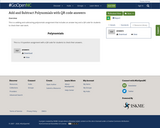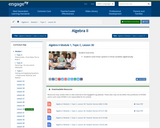
This is a adding and subtracting polynomials assignment that includes an answer key and a QR code for students to check their own work.
- Subject:
- Algebra
- Math 1
- Material Type:
- Homework/Assignment
- Author:
- KORI ELLIOTT
- Date Added:
- 06/01/2020

This is a adding and subtracting polynomials assignment that includes an answer key and a QR code for students to check their own work.

The Advanced Data Grapher can be used to analyze data with box plots, bubble graphs, scatterplots, histograms, and stem-and-leaf plots. You can enter multiple rows and columns of data, select which set(s) to display in a graph, and choose the type of representation.

Students solve linear systems in three variables algebraically.

Students develop facility with graphical interpretations of systems of equations and the meaning of their solutions on those graphs. For example, they can use the distance formula to find the distance between the centers of two circles and thereby determine whether the circles intersect in 0, 1, or 2 points.
By completing the squares, students can convert the equation of a circle in general form to the center-radius form and, thus, find the radius and center. They can also convert the center-radius form to the general form by removing parentheses and combining like terms.
Students understand how to solve and graph a system consisting of two quadratic equations in two variables.

Students use geometric sequences to model situations of exponential growth and decay.
Students write geometric sequences explicitly and recursively and translate between the two forms.

Students draw a smooth curve that could be used as a model for a given data distribution.
Students recognize when it is reasonable and when it is not reasonable to use a normal curve as a model for a given data distribution.

Students define appropriate quantities from a situation (a “graphing story”), choose and interpret the scale and the origin for the graph, and graph the piecewise linear function described in the video. They understand the relationship between physical measurements and their representation on a graph.

Students choose and interpret the scale on a graph to appropriately represent an exponential function. Students plot points representing number of bacteria over time, given that bacteria grow by a constant factor over evenly spaced time intervals.

Students develop the tools necessary to discern units for quantities in real-world situations and choose levels of accuracy appropriate to limitations on measurement. They refine their skills in interpreting the meaning of features appearing in graphs.

Students interpret the meaning of the point of intersection of two graphs and use analytic tools to find its coordinates.

Students use the structure of an expression to identify ways to rewrite it. Students use the distributive property to prove equivalency of expressions.

Students use the commutative and associative properties to recognize structure within expressions and to prove equivalency of expressions.

Students understand that the sum or difference of two polynomials produces another polynomial and relate polynomials to the system of integers; students add and subtract polynomials.

Students understand that the product of two polynomials produces another polynomial; students multiply polynomials.

Students understand that an equation is a statement of equality between two expressions. When values are substituted for the variables in an equation, the equation is either true or false. Students find values to assign to the variables in equations that make the equations true statements.

Students understand that an equation with variables is often viewed as a question asking for the set of values one can assign to the variables of the equation to make the equation a true statement. They see the equation as a “filter” that sifts through all numbers in the domain of the variables, sorting those numbers into two disjoint sets: the Solution Set and the set of numbers for which the equation is false.
Students understand the commutative, associate, and distributive properties as identities, e.g., equations whose solution sets are the set of all values in the domain of the variables.

Students learn if-then moves using the addition and multiplication properties of inequality to solve inequalities and graph the solution sets on the number line.

Students describe the solution set of two equations (or inequalities) joined by either “and” or “or” and graph the solution set on the number line.

Students solve two inequalities joined by “and” or “or,” then graph the solution set on the number line.

Students learn that equations of the form (x - a)(x - b) = 0 have the same solution set as two equations joined by “or:” x - a = 0 or x - b = 0. Students solve factored or easily factorable equations.